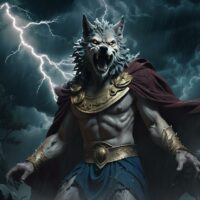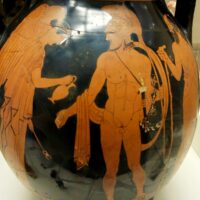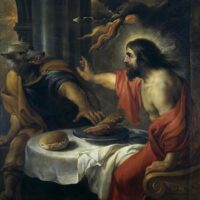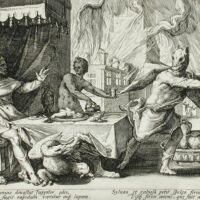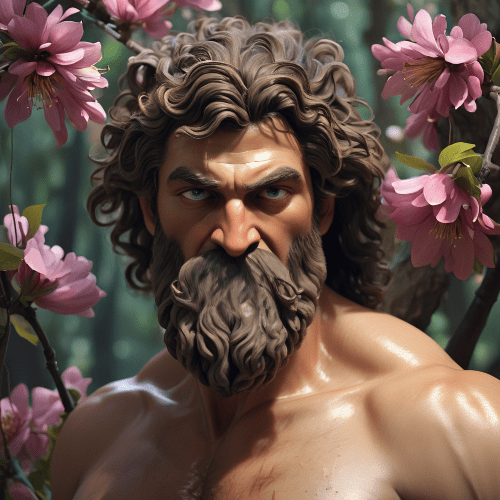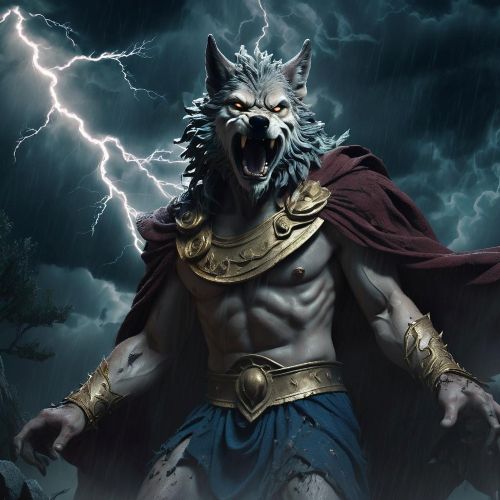
Lycaon : The Greek Werewolf
Listen
At a glance
| Description | |
|---|---|
| Origin | Southern African Mythology |
| Classification | Hybrids |
| Family Members | N/A |
| Region | South Africa, Namibia |
| Associated With | Evil, Man eating |
Lycaon
Introduction
Lycaon stands out in Greek mythology as both a cautionary figure and a cultural pioneer. As the king of Arcadia, his legacy is wrapped in a tale that blends arrogance, sacrilege, and divine transformation. His name is most often associated with the dark myth where he dared to test Zeus by offering the god a meal tainted with human flesh. The punishment was swift and brutal: Lycaon was transformed into a wolf, giving birth to one of mythology’s earliest werewolf stories. Yet beyond this gruesome legend, Lycaon is also remembered for contributing to the civic and religious life of Arcadia, founding Lycosura and establishing rituals and games that would shape Greek tradition for generations.
Physical Traits
Descriptions of Lycaon’s appearance before his transformation are sparse, which is common for mortal kings in ancient myths. However, it’s his grotesque change that captures the imagination. Once cursed by Zeus, Lycaon took on the terrifying attributes of a wolf—towering in size, covered in dark fur, and possessing glowing red eyes that seemed to radiate his inner savagery. Ancient sources often emphasized this physical transformation not just as a change in form, but as a mirror of the moral decay within. The foaming mouth, the lashing tongue, the beast-like howls—all these features symbolized the fall from human reason into primal brutality.
Family
Lycaon’s family tree is sprawling and foundational to many other Greek myths. He was born of Pelasgus, a primeval king often linked to the origins of Greek civilization itself, and either the Oceanid Meliboea or the mountain nymph Cyllene. He married within the divine or semi-divine circles as well, most notably with Cyllene in some accounts, reinforcing his mythological importance.
But Lycaon’s greatest familial legacy lies in his children. He fathered a staggering 50 sons, each said to have founded cities across Arcadia, leaving a permanent mark on the region’s geography and mythos. These sons were often portrayed as reckless and impious, mirroring their father’s notorious traits. Among them, Nyctimus, the youngest, holds a tragic place in the myth—either served as a grotesque feast to Zeus or saved by divine intervention, depending on the version. Lycaon’s daughter Callisto is also of mythological importance; transformed into a bear and later immortalized among the stars, she carried on the cursed legacy in a celestial form.
Other names
Lycaon’s very name, drawn from the Greek lykos (wolf), is an etymological anchor to his myth. This connection would later birth the word lycanthropy, used to describe the supernatural or psychological transformation of a human into a wolf. While he is primarily known simply as Lycaon, mythographers and historians sometimes refer to him with titles that reflect his moral status, such as “Lycaon the Impious” or “King Lycaon of Arcadia.” Importantly, this Lycaon should not be confused with another figure of the same name—a Trojan prince killed by Achilles in the Iliad—highlighting the mythological tradition’s complexity.
Powers and Abilities
Though mortal, Lycaon’s story endowed him with extraordinary traits—albeit as punishment. After Zeus’s wrath, he became a werewolf-like creature, embodying qualities that have since become staples in werewolf mythology. These include enhanced physical strength, heightened senses, and incredible speed. More symbolically, Lycaon’s transformation is said to have made him immortal, forever cursed to wander in beastly form. In later interpretations, particularly in fantasy and horror literature, he is sometimes described as immune to conventional weapons, vulnerable only to silver—a trait now commonplace in werewolf lore.
This evolution in portrayal—from a punished king to the progenitor of werewolves—reflects not only the ancient fascination with punishment and metamorphosis but also how myths adapt to new cultural contexts over time. In this sense, Lycaon serves as the archetype of the first werewolf, a bridge between man and beast, myth and metaphor.
Modern Day Influence
The myth of Lycaon continues to cast a long shadow in contemporary storytelling. His tale has fueled the imagination behind countless werewolf legends, appearing in books, television, and video games. One of the most well-known retellings comes from Ovid’s Metamorphoses, where the story is told with chilling vividness. From there, Lycaon’s narrative found echoes in medieval bestiaries, Gothic horror, and eventually modern cinema.
In popular media, Lycaon has taken on various forms. He features in the TV series Teen Wolf as part of the lore surrounding werewolf origins. Video games such as Zenless Zone Zero include characters inspired by his myth, showcasing wolf-like traits and a rebellious spirit. Even in international pop culture, Lycaon resonates—he’s affectionately referred to as “Wolf Bro” by Chinese fans, underlining how mythological figures can transcend cultures and languages.
The psychological term lycanthropy, referring to a delusional belief in turning into a wolf, directly links back to Lycaon’s myth, demonstrating how deeply rooted his legend is in our collective psyche. Academics continue to analyze his story for insights into ancient Greek notions of justice, transformation, and human nature. In this way, Lycaon lives on—not just as a myth, but as a symbol of the animal lurking within, of boundaries crossed, and consequences faced.
Its legend continues to shape Southern African folklore, acting as a cautionary tale about the perils of wandering alone at night. The creature’s fearsome image has also found its way into various artistic and literary works, keeping its myth alive in modern storytelling and cultural discourse.
Related Images
Source
Apollodorus. (1921). The Library (J. G. Frazer, Trans.). Harvard University Press.
Graves, R. (1955). The Greek Myths. Penguin Books.
Hyginus, G. J. (1960). Fabulae (M. Grant, Trans.). University of Kansas Press.
Pausanias. (1918). Description of Greece (W. H. S. Jones, Trans.). Harvard University Press.
Theoi Project. (n.d.). Lycaon (Lykaon). Retrieved from https://www.theoi.com/Heros/Lykaon.html
Greek Mythology.com. (n.d.). Lycaon. Retrieved from https://www.greekmythology.com/Myths/Mortals/Lycaon/lycaon.html
Wikipedia contributors. (n.d.). Lycaon (king of Arcadia). Wikipedia. Retrieved June 2025, from https://en.wikipedia.org/wiki/Lycaon_(king_of_Arcadia)
Frequently Asked Questions
What is lorem Ipsum?
I am text block. Click edit button to change this text. Lorem ipsum dolor sit amet, consectetur adipiscing elit. Ut elit tellus, luctus nec ullamcorper mattis, pulvinar dapibus leo.
What is lorem Ipsum?
I am text block. Click edit button to change this text. Lorem ipsum dolor sit amet, consectetur adipiscing elit. Ut elit tellus, luctus nec ullamcorper mattis, pulvinar dapibus leo.
What is lorem Ipsum?
I am text block. Click edit button to change this text. Lorem ipsum dolor sit amet, consectetur adipiscing elit. Ut elit tellus, luctus nec ullamcorper mattis, pulvinar dapibus leo.
What is lorem Ipsum?
I am text block. Click edit button to change this text. Lorem ipsum dolor sit amet, consectetur adipiscing elit. Ut elit tellus, luctus nec ullamcorper mattis, pulvinar dapibus leo.
What is lorem Ipsum?
I am text block. Click edit button to change this text. Lorem ipsum dolor sit amet, consectetur adipiscing elit. Ut elit tellus, luctus nec ullamcorper mattis, pulvinar dapibus leo.


